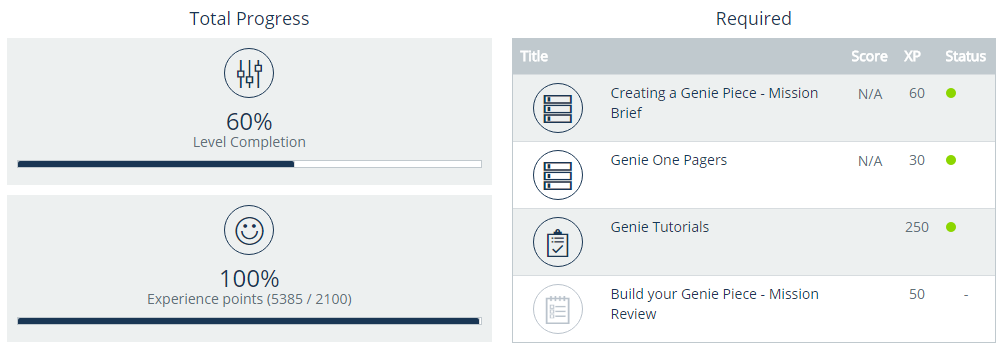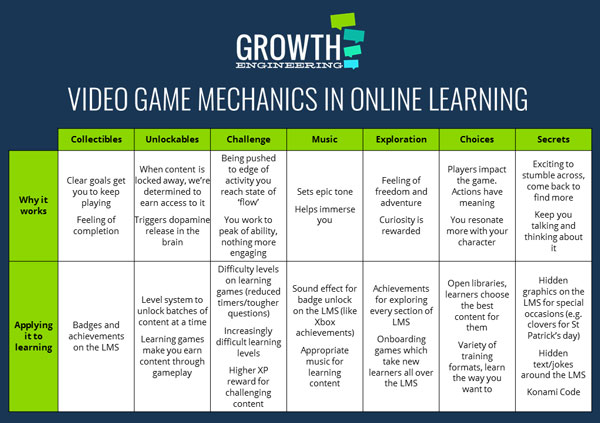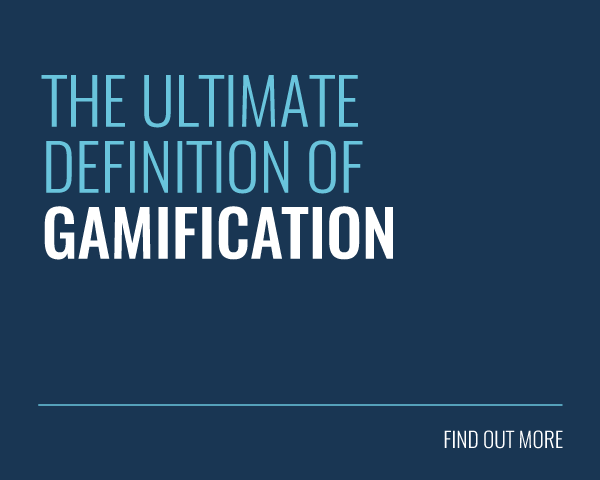 Around two billion people play video games, and the global video game market will generate almost $100 billion in 2016. That’s a lot of players, and an awful lot of spending, but what are the game mechanics behind this success?
Around two billion people play video games, and the global video game market will generate almost $100 billion in 2016. That’s a lot of players, and an awful lot of spending, but what are the game mechanics behind this success?
A large factor in the success of video games is their ability to engage players in ways other media can’t. You’re not just a passive observer watching a narrative unfold. Instead, you take centre-stage, playing a leading role in events, and ultimately forming your very own story.
Of course, it would have been impossible for the success of video games to slip under the radar. That’s why so many companies have caught onto the notion of gamification:
The application of typical elements of game playing (e.g. point scoring, competition with others, rules of play) to other areas of activity, typically as an online marketing technique to encourage engagement with a product or service.
Game mechanics now show up in just about everything – Store loyalty cards, air miles, sales leaderboards, Fitbit, and even eating your ‘5 A Day’!
Game Mechanics in Online Learning
But it’s the world of online learning which has seen some of the most extensive use of gamification.
If you’ve experienced earlier attempts at online learning, then you probably slipped into a coma immediately afterwards. Online learning can be mind-numbingly boring.
But now the power of game mechanics is engaging learners with their training. This improves their information retention, and ultimately makes a training programme much more effective!
So which game mechanics, in particular, can you expect to find in the world of online learning? Let’s take a look!
Game Mechanic #1: Collectibles
Collectables are among the most prevalent mechanics in video games. Pac-Man collects pellets, Mario collects coins, and Sonic collects rings – It’s a winning convention!
Most games include collectables of some kind. Some simply need to be found, while for others (achievements and trophies) you need to complete a specific task.
Although collectables have been around forever, games don’t always get them right… For example, take a look at the first Assassin’s Creed game released in 2007.
This ambitious game provided 3D replicas of entire cities, letting the player climb up every building they found. Needless to say, this left the player with an enormous world to explore, both horizontally and vertically.
Game Mechanics: Hidden Treasures
Hidden within the game are 420 flags to collect. They’re small and almost invisible as you run past, making them extremely difficult, and downright tedious to find.
Just take a look at how much some of these blend into the dense environment:
To add insult to injury, anyone masochistic enough to track down every flag would only receive an achievement.
Compare and contrast with a game released nearly a decade earlier – Banjo-Kazooie.
Banjo-Kazooie is often referred to as a ‘collect-a-thon’ because collecting is the dominant mechanic throughout the game. Throughout your adventure, you collect jigsaw pieces, musical notes, honeycombs, scrolls, bird-like creatures called Jinjos, skulls, eggs, and feathers, among other things.
While this might sound as overwhelming as Assassin’s Creed, the game is broken up into self-contained levels. Each one is of a manageable size, and the menu shows what you need to collect. This makes it easy to keep track of where you are, and what you still have left to do.
In this way, collectables offer the player clear goals to work towards. They get you to keep playing and give you a real feeling of completion once you’ve found everything.
Collectables in online learning
 To host and deliver online learning, you need a learning management system or LMS. Learners might flock to it when it launches but you might face one of the biggest in L&D. How do you get people to keep coming back on a regular basis?
To host and deliver online learning, you need a learning management system or LMS. Learners might flock to it when it launches but you might face one of the biggest in L&D. How do you get people to keep coming back on a regular basis?
That’s why collectables become so appealing. Training providers have taken the idea of achievements from the world of video games and applied them to the LMS.
As learners complete their training, they’ll earn badges. In their badge cabinet, they can see what they need to earn, and how to earn them. This gives them a clear goal to work towards.
Often, these badges apply to another video game convention, the leaderboard. This adds an incentive to come back, collect more badges and overtake their peers.

Game Mechanic #2: Unlockables
Video games are unique in being the only form of media to actively restrict your access to content.
When you watch a film or read a book, you can sit back and take everything in. But when you play a video game, there’s no time for relaxation. You have to earn the right to unlock and access the rest of the game!
We’re a stubborn species. When something tells us ‘no’, our instinct is to go ahead and do it anyway. When a game locks the content away, we put in the extra effort to prove that we deserve access.
Every time we earn an unlockable, our brains receive a small burst of dopamine, the feel-good hormone. This leads us to associate them with positive emotions and makes us want to repeat the action again and again.
Call of Duty 4: Game Mechanics Masters
Some game developers have mastered the art of unlockables. 2007’s release of Call of Duty 4: Modern Warfare is a great example. Though the series has since received criticism for failing to innovate, COD4 was a game-changer in 2007 (pun intended).
A lot of the appeal was down to the tight controls and fast-paced shooter gameplay. However, what kept people coming back for years was the online multiplayer. Its robust progression system awarded experience for playing well and allowed the player to level up.
But these levels weren’t just for show. Each level unlocked a brand new weapon, new equipment, or a new ability for you to use in-game. As you unlock more weapons and equipment, you can build your perfect loadout. Oorah!
These were meaningful rewards, and players kept coming back to unlock every single one. If the thrill of unlocking was too great, players could activate ‘Prestige Mode’ once they reached the highest level. This reset their progress and started them all over again from Level 1!
Unlockables in online learning
The levelling system we’ve seen in Call of Duty is also used in online learning. Content can be structured into levels, and experience points can even be earned. Once a learner has earned enough experience they will level up, and unlock access to the next batch of content.

Content can also be placed within learning games. In these, the learner will play a game, and doing well will unlock a snippet of content. They’ll need to keep playing well to earn access to all of the content and to complete the unit.
In both of these examples, the learning content itself is the unlockable reward. This helps to engage learners and makes the content something that they desire access to.
Game Mechanic #3: Difficulty
As gamers, there are a few things we hate more than hand-holding. Long tutorial missions and easy levels leave us feeling patronised and as though we haven’t achieved anything.
By contrast, when games really challenge us, they push us to the edge of our abilities. This sets our brains into what psychologists call ‘flow’. This is the most engaging state for our brains and lets us work at the peak of our ability.
Back in the day, hardware limitations meant that game developers could only fit so much content onto a cartridge. To keep people playing longer, and to help them feel as though they were getting their money’s worth, games were intentionally made more difficult.
Battletoads
We could pick any number of games to illustrate this, but let’s take a look at Battletoads. Released in 1991, it’s often considered to be one of the most difficult games on the NES, and features a great variety of gameplay between different levels.
You start off punching enemies on foot, next you’re abseiling, then you’re piloting an odd spinning wheel… Here is the infamous turbo tunnel, which has stopped many players in the tracks:
The entire game can be beaten in 30 minutes (speedrunners finish it in under 13 minutes!), but mastering each type of gameplay will take hours of practice.
Dark Souls
A more recent example is the Dark Souls series. This is an action game where even the weakest enemies can easily kill you in a few hits. There is no optional difficulty level, you just have to cope with everything that it throws at you, and new players quickly get used to seeing the ‘YOU DIED’ screen.
But although the game is challenging, it’s always fair. As long as you’re skilled and careful enough, you can get through any situation it presents to you.
Every time you reach a bonfire checkpoint or defeat a boss, you get a sense of progression which most games can’t match. You’ve moved forwards just a little bit, but you worked damn hard for it, and so you’re rightfully proud of yourself!
Difficulty in online learning
Online learning can often end up becoming a box-ticking exercise where you simply click through slides without taking anything in. It’s too easy, and so it fails to stimulate the brain into action.
Learning games are able to add some element of challenge. Learners need to get through the game to reach the content, and higher difficulty levels might present them with tighter time limits or tougher question sets.
The level system we talked about earlier can also be used. Early levels can start off simply, and then more complex content can be offered at higher levels, keeping learners at the edge of their abilities and in a state of flow.
Tougher content might also have a higher reward, such as offering more experience points. This encourages learners to seek out more difficult learning and to challenge themselves.
Game Mechanic #4: Sound
We often think of video games, films and TV shows as being visual media, but that doesn’t do justice to all of the audio that goes with them. The more senses you can engage, the more immersed the audience will be.
Just like in films, music in video games helps to set the tone and immerse you into the scene. Let’s listen to an iconic score from the Halo series of games:
This is an epic game which sees you take on the role of a super soldier, fighting against aliens to secure humanity’s future! So you can see how this music fits pretty well.
But can you guess where this music plays? A massive battle? The grand finale? Nope. This music is actually what plays on the main menu.
Before you’ve done anything, before you’ve even picked up your controller, you’re pumped up, ready to head out and save the human race!
Metroid Prime
Now let’s look at how music can be used to immerse the player into specific situations. To do this, we’ll look at the 2002 game Metroid Prime.
This masterpiece stands as one of the most highly-acclaimed games of all time. It’s a sci-fi shooter which sees your ship crash-land on a mysterious planet. As you explore the world, you’ll come across a wide variety of areas, and music to match.
Compare and contrast these two areas – one features fire and lava, the other snow and ice.
The lava area has a heavy drum beat, which feels as though you’re listening to your character’s heartbeat. You can tell that she’s stressed, knowing that one false step will mean falling in the lava, and you want to get out of this place as soon as possible.
By complete contrast, the very next area in the game is the snowy one. The music here becomes peaceful, relaxing, mysterious, and it makes you want to spend time exploring this location.
Sound in online learning
The Xbox achievement sound is very recognisable, and players come to associate the sound with success. It’s addictive, and you get a small rush every time you hear it, knowing that you’ve just earned a reward.
This can be replicated on the LMS by having a distinctive sound effect play whenever a learner earns a badge. Again, learners come to associate the sound with success, and it helps to encourage them to keep completing content and earning more badges.
As for the training itself, silent eLearning content is lifeless and uninspiring, so adding some appropriate music can go a long way in terms of engagement. It might seem difficult to make something like compliance training interesting, but even simple sound effects can aid immersion and help the information sink in.
Game Mechanic #5: Exploration
Some video games are linear, forcing you to follow a set path and do things in a predetermined order. But others will open up that world for you to run around and explore to your heart’s content, giving you a sense of freedom and adventure!
There are countless examples of vast, open-world games, with one of the most popular being Skyrim. This world is 15 square miles large on the surface, and also features hundreds of buildings, caves and ruins to visit.
In this game, if you can see something, you can walk over to it (though watch out for the occasional dragon getting in your way). You can put in dozens of hours without even scratching the surface of the main storyline, simply because you get so caught up in traversing the world.
Exploring the Blind Forest
Even much smaller games can still place a big emphasis on exploration. In 2015, a fantastic 2D platformer was released, called Ori and the Blind Forest.
The map is vast and complex. Players are able to take direct routes to each destination, but you’ll notice that spending time on exploration will uncover hidden areas with power-ups which help you complete the game.
The curiosity of players is rewarded, and so they spend more time playing the game trying to discover everything.
Exploration in online learning
An LMS can be very feature-rich. As well as delivering training content, it might include calendar functionality, an ‘ask the experts’ area and even social groups for discussions. Unfortunately, a lot of learners will turn up to complete their training and then leave, missing out on all this extra value.
This is why it’s important that learners are encouraged to explore their shiny new system. One way this is done is by having special badges trigger when a learner visits or uses each section of the platform. Their hunt for the badge will lead them there.

Some learning and development teams are more ambitious, designing elaborate games for new learners!
For example, a learner might be invited to download a document with a series of clues. Following these clues will lead them to different areas of the platform, where they’ll find more clues to take them further on their journey. Those who make it to the end will win a prize, but the real reward will be knowing their new LMS inside out!
Game Mechanic #6: Decisions
As well as creating vast worlds for players to explore, game developers are increasingly giving the player the opportunity to make decisions. Needless to say, things mean a lot more to us when we have some control over them.
Some decisions will be fairly trivial, perhaps giving you one unique item over another. Other decisions can have a huge impact on the game-world itself, and you can have a vastly different experience depending on what you choose.
An example of the latter is a game which Poland is so proud of that their prime minister gave a copy to President Barack Obama – The Witcher 2: Assassins of Kings
The central chapter of this game features a city under siege. A key decision made by the player will determine which side of the battle they find themselves on, either joining the attacker’s camp or the defending city. Both sides offer completely different content and experiences.
Games With Consequences
But a series which takes decisions to a galactic scale is Mass Effect. Imagine playing through the entire box sets of Star Trek and Star Wars combined, and you’ll have some idea of the scope of this space-opera.
Throughout this game trilogy you’ll have thousands of conversations and make hundreds of decisions, all of which can affect the way the story plays out. What makes the series unique is that the decisions you make in one game are saved and carried over to the sequels.
This video is of an interactive comic, summing up the story and key decisions of the first game (if you want to avoid spoilers, then go and play the game right now!):
If your actions lead to any characters dying in Mass Effect 1, then they’ll remain dead for the rest of the series. If you weigh in on wars between alien species, then your decisions will have huge consequences further down the line.
By the end of Mass Effect 3, you’ve spent hundreds of hours crafting your own complete story. You resonate with your character and everything else going on, and you feel as though your actions have driven the events of the game. (Now let’s move on without having to discuss the final game’s stratospheric disappointment of an ending…)
Decisions in online learning
The choice is beginning to play more of a role in online learning, allowing learners to take personal development into their own hands.
Lots of organisations are finding value in placing the bulk of their training into open libraries. This means that any learner, regardless of role or department, can access all of the content on the platform.
These learners can choose which content they want to complete, and proactive learners are able to pick up new skills which might help them seek promotions.
Training topics will also be covered in a wide variety of formats, allowing learners to learn the way they want to. Whether they want to download a document, watch a video, take an in-depth eLearning unit, or play a learning game, it’s entirely up to them!
Game Mechanic #7: Secrets
Secrets and Easter eggs can be found in just about every game, as long as you’re keeping an eye out for them.
They can be simple, such as a well-hidden sign in Grand Theft Auto 3 saying ‘You weren’t supposed to be able to get here you know’. That’s nice and easy, and a little bit of fun.
Or they can be more complex, such as this outrageous secret hidden in Battlefield 4:
It requires you to decipher Morse Code in Belarusian, find a number of ridiculously well-hidden buttons (one of which requires flying a helicopter up a cliff and blowing up a tree), solve a logic puzzle involving lights, follow clues to a secret location, use audio manipulation software to reverse/speed up/alter the pitch of something you hear, understand a reference to a YouTube video, input a code, solve more Belarusian Morse Code, and then input a final code.
Wow. And after all that, all you earn is a new outfit (seriously). But this sort of secret engages entire game communities, who work together to try and solve it, generating buzz and discussion around the game itself.
Back To Banjo-Kazooie…
For a better example of this let’s return to Banjo-Kazooie, one of the games we started off with and the owner of one of the most infamous secrets in video game history:
Your reward for collecting everything in the game is to see photos of secret areas and items you missed, and discover that you’ll find out more about them in the next game. But hold on… We’ve collected everything already. We couldn’t possibly have missed anything!
Banjo-Kazooie was released in 1998 and the sequel, Banjo-Tooie would be released in 2000. This was back in the dark ages before Googling everything was commonplace, so countless players spent two long years trying everything they could to open up these secret areas, sharing their progress updates amongst their friends.
When Banjo-Tooie finally reached the homes of its avid fans, the promised revelation never came. This of course only added to the mystery, and so the game would continue to be played and discussed.
The Truth Comes out…
Many years later the truth finally came out, and it turned out to have all been related to hardware limitations. The developers wanted to transfer information between the two games, similar to what Mass Effect would do a decade later. Data from the second game would unlock the secret areas in the first game, and players could transfer their collected items back to the second game.
Unfortunately, this was before hard drives and memory cards were prevalent in video game consoles, so the proposed method of transferring data was to quickly swap the game cartridges. However, for newer models of the Nintendo 64 the window to do this would only about one second, and Nintendo themselves were concerned that people would damage their consoles, so they shut the project down.
Even so, this secret feature (known as Stop ‘N’ Swop) has kept the game at the front of many players’ minds for nearly 20 years. The developers are still revealing new information about it to this day, proving just how much of a factor secrets can play in engaging people.
Secrets in online learning

Creative learning and development professionals are able to make great use of the power of secrets. For instance, St Patrick’s day will often see LMS administrators hide shamrocks all over their platforms. Finding all of them might earn the learner a prize, sparking a buzz and setting the entire learner base on a manic hunt.
It’s easy enough to hide small Easter eggs throughout a platform as well. It could be a joke hidden in the site’s footer, something fun in the source code, or it could even be that something unexpected happens when you type out the Konami Code.
There’s plenty out there for an inquisitive learner to stumble upon!
To sum up…
So there we have it! Seven different mechanics used in video games, which are already prevalent in the online learning industry. These are just some of the many ways in which video games are influencing the world of learning and development.
To recap what we’ve looked at:

If you’re looking to find out more about gamification in online learning, then get in touch with us! We help organisations to deliver engaging training programmes through our gamified, social Academy LMS. Get in touch to book a free demo:









